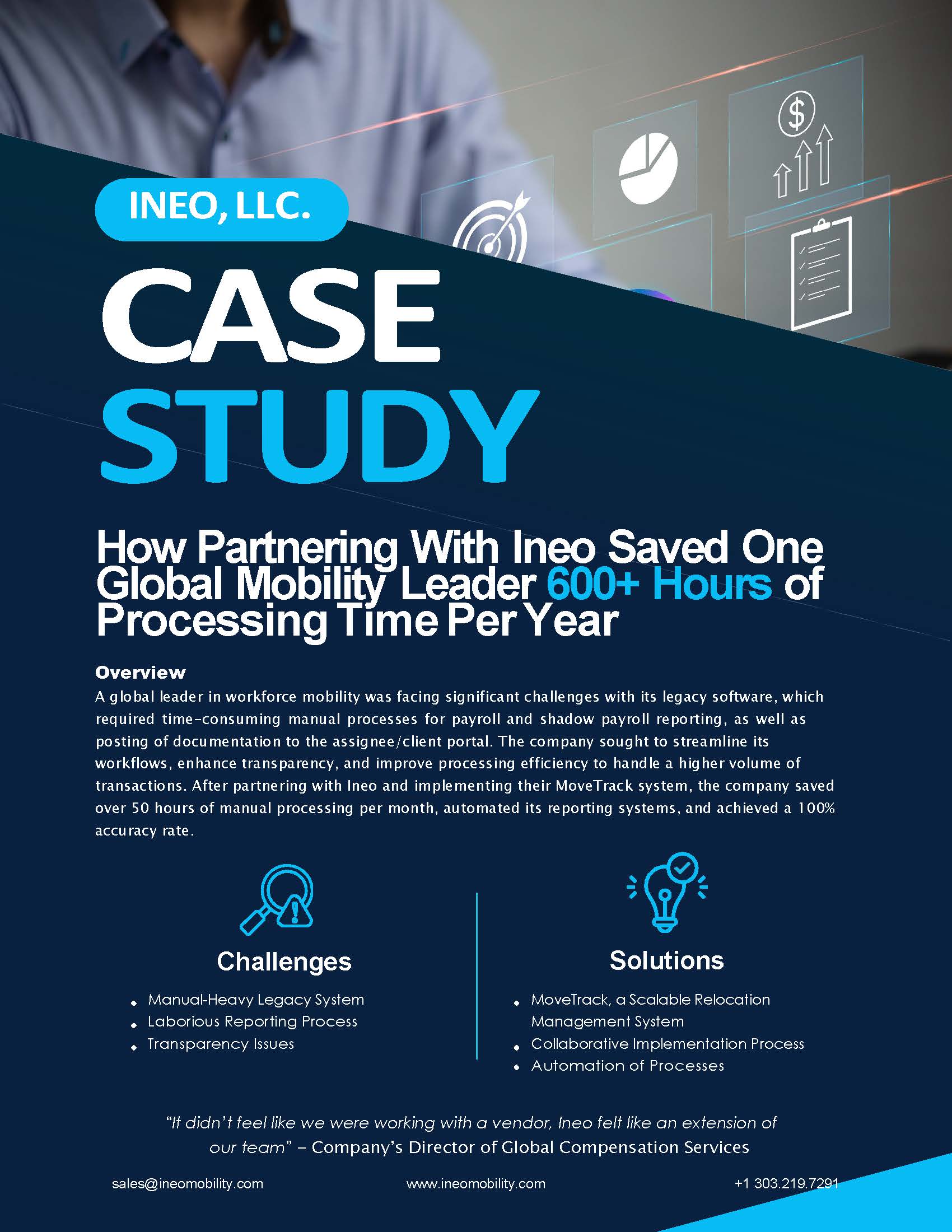So, What is Global Mobility?

What is Global Mobility?
Global mobility, better known as the ability to transfer and relocate employees to international and domestic locations, has many functions that expand across an organization. The past few years have created an increased need for global mobility, in part due to the pandemic, demand for remote work, and technological advancements. Global mobility is no longer an option for consideration; both the talent you need and your business trajectory require it.
From logistics, immigration laws, compliance, and HR, global mobility is a vital strategy for advancing the future of your workforce. Here at Ineo, we believe that at its core, global mobility should begin and end with utilizing mobility to achieve organizational talent goals.
Let’s explore how global mobility can be incorporated to ensure your program is effective and mutually beneficial for your organization and your employees.
Used to strengthen career paths
Having an established system for internal career growth can help you use global mobility to center and advance your employees’ career trajectory and goals. Today’s talent seekers are on the hunt for work opportunities that will allow them to grow, develop new skills, and feel challenged while maintaining a sense of security, especially during times of economic uncertainty and changing career landscapes. Streamlining your onboarding process, reskilling employees, and simply being transparent about the viability of internal growth opportunities can demonstrate strong career mobility to current and future employees.
Additionally, creating employee career paths, whether for short-term skills to master or potential roles they can achieve, has valuable benefits: reduced turnover rates, higher employee satisfaction, and strengthened hard and soft skills for employees are just some of the many. While international assignments are highly sought opportunities because employees can develop personally and professionally, there is the added advantage that international assignments look great on an employee’s resume and can enhance their career goals. With that being said, you’ll want to ensure that with your talent’s new skill set and impressive resume, they are still satisfied with their role post-assignment; this is a crucial factor in order to retain repatriated employees. On the other hand, international assignments can be costly, especially if it results in a failed assignment. Incorporating global mobility into your strategic workforce planning to build employee skills and create career paths is not only cost-effective, but it also helps keep your employees engaged and challenged within your company.
Enhance ROI
Global mobility and its impact on your ROI extend beyond corporate benefits and embraces the employees involved in international assignments. In most cases, employees accrue personal and professional net benefits from working on assignments. The knowledge, skills, and experiences employees gain during assignment contribute to an increase in your company’s ROI in terms of performance, job satisfaction, and their intent to leave.
In turn, the many benefits of global mobility for employees becomes a benefit to the company over time through increased ROI. Determining the metrics used to calculate your ROI is important for measuring the success of your global mobility program and can also help you calculate your ROI from global mobility before, during, and after the assignment. Whether it’s reducing the amount of failed assignments, determining which employees are the best candidate for the assignment, or restructuringassignment packages, understanding your ROI is critical to achieving a positive business trajectory. Try using Ineo’s Cost Estimate Tools to help you evaluate program costs for long-term, short-term, and global one-way assignments.
Talent Organizational Goals
Naturally, global mobility and talent recruitment go hand-in-hand. Whether your company is in the initial stages of incorporating a global mobility program or already have an established program, obtaining top talent is essential to your ability to mobilize your workforce. Global mobility is also a key contributor to recruitment and retention efforts by offering new opportunities for employees to develop and further their careers internationally. When an employee works in a foreign country, they may likely encounter different perspectives as they navigate new skill development and cultural enrichment. Let’s face it, finding (and retaining) quality talent is just as hard as being on the job-search side of things, and having a competitive package to offer your potential new employee is key to hiring long-term, successful talent. Including a domestic relocation or international assignment opportunity as a part of that package is a huge way to increase interest in working at your organization.
Global mobility can also address talent and workforce limitations by allowing your company to expand into global talent pools. While traditional methods of global mobility involve relocating talent from country to country, alternative forms of assignments can leverage the lifestyle and expectations of newer generations. For example, virtual assignments or opportunities for third-country assignments can offer additional flexibility to digital nomads and help you save on expatriation costs. Hiring local talent can also give your company a competitive advantage in achieving your DEI and talent organizational goals.
Culture and DEI:
When employees embark on assignments, they are exposed to different cultures and experiences, which helps enrich their perspectives as global-aware leaders. It’s likely your workforce demographics will change as your company expands globally and your organization will need to have DE&I strategies in place to address and embrace cultural diversity. Establishing DEI-focused global mobility strategies is a growing theme worldwide, and it can advance your diversity, equity, and inclusion strategic goals as you widen your talent pool.
Fostering an inclusive work environment that values DEI can help you fully utilize your employees’ talent and build an internal talent pipeline for succession. As a part of the competitive package we mentioned above, current and future talent will want to know that your workplace emphasizes and values diversity and inclusion and that their specific needs or differences won’t hinder their ability to receive equitable opportunities. Reviewing your global mobility policies and benefits on a regular basis will help determine if your organization is serving all demographics equitably. Overall, ensuring that your global mobility goals are aligned with DEI will ultimately improve your recruitment and retention efforts.
Utilizing Ineo to Assist you in Managing a Competitive Global Mobility Advantage Program
When incorporated strategically, global mobility can push forward your company and current/future employees, leading to a better, well-rounded, productive, and loyal workforce. For business leaders, developing global mobility solutions can be complicated. The Ineo Platform is equipped with the functionality and tools you need to build a mutually beneficial mobility program to achieve your organizational talent goals and more. Want to learn more? Schedule a call with us today!
Global Mobility Resources
Learn more about what’s going on at Ineo and insights into the complex world of global mobility from the industry’s top thought leaders and innovators.
Request A Demo
Whether you are new to the world of global mobility or you’ve been in the business for a while, Ineo is here to assist you.
The best way to learn how Ineo’s global mobility software can help your company revolutionize your global mobility program and support your business strategy is to see it in a demo.
Fill out this form to get started today.
Get Started

